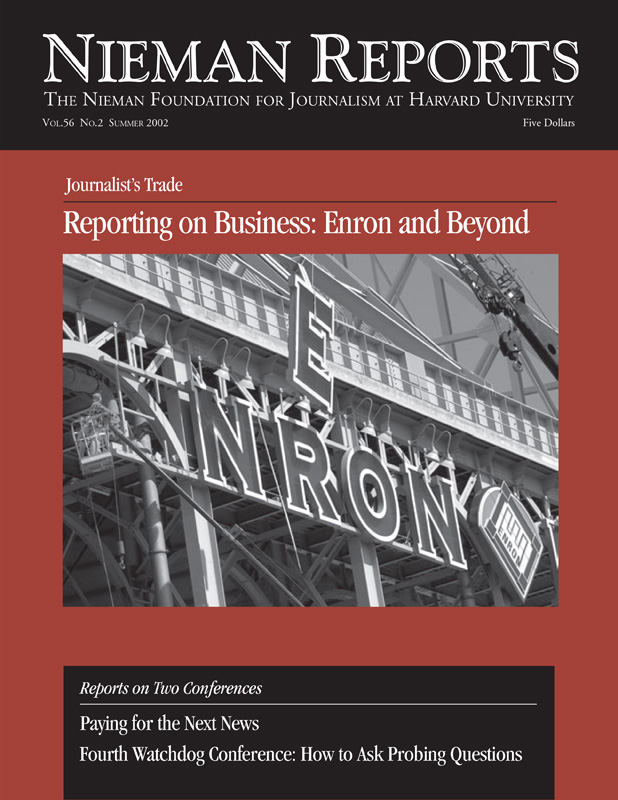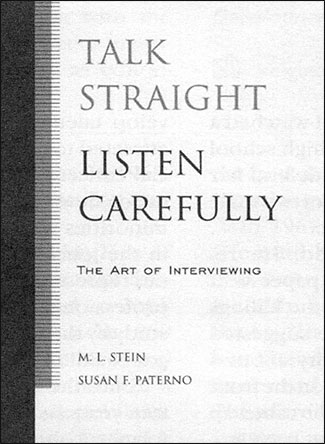A television reporter was questioning a think-tank expert about the Taliban’s dominance of Afghanistan, when the source mentioned the country’s civil war in which the Taliban was engaged.
“Civil war?” the interviewer asked. She looked surprised.
Her source then offered a brief background of the struggle between the Taliban and the Northern Alliance. It was embarrassingly obvious that this reporter knew nothing about Afghanistan’s internal conflict that had been raging for years. Bluntly: She was unprepared for the interview.
This is not meant as a general criticism of television reporting. The medium also fields astute journalists like Christiane Amanpour and Aaron Brown of CNN, Brian Williams of MSNBC, and ABC’s Peter Jennings and Ted Koppel, who ask penetrating questions that generate news. And, as we know, there are print reporters who are less than incisive when it comes to nailing down fruitful information.
However, the failure of the clueless questioner to do her homework emphasizes the need for soaking up background before the interview. None of us can know everything, but we can dig into reference material and tap sources to fill in the gaps in our knowledge about a subject we are being asked to report on. Such preparation eliminates the chance of asking unfocused questions or those that elicit only yes or no answers. It also enables the reporter to frame insightful questions using the words “how” and “why,” a technique that prevents those being interviewed from responding with a shake or nod of the head.
“The key is to be prepared,” says Bill Nottingham, senior regional editor for the Los Angeles Times. Recalling his days as a reporter, he says that he would write out questions prior to an interview “and note how I might follow-up if the person answered ‘yes’ or ‘no.’ Plus, I always tried to toss in a question I already knew the answer to, so I could test the source’s truthfulness.”
Before arranging an interview, reporters should ask themselves what their story is about and determine what questioning will best transmit the story’s focus to their audience. Once a reporter has a story idea, the job becomes to hunt down experts and, if the idea is controversial, contact supporters and opponents. Search the Internet. Collect clips on the topic. “You will conduct better interviews if you broadly research your subject,” says Eric Nalder, who won a Pulitzer Prize at The Seattle Times. If the story involves corruption by a public official, he advises: “You’d better know who that person is and what he does. Find out everything you can about his particular job and agency before making a single phone call.”
Breaking Down Barriers
The road to a successful interview can be strewn with barriers. For some sources, an encounter with a reporter is a new and frightening experience—or they might just dislike the media. Others may be shy, inarticulate or intensely private in nature. Then there is the individual in trouble—under indictment, facing bankruptcy, politically damaged or a fallen hero. Expect a defensive posture, although this person might readily pour out his or her side of the issue to balance the story.
Different sources require different approaches. John Fried, a veteran newsman for The Wall Street Journal and The Philadelphia Inquirer, once told a journalism class: “Start an interview with a tough or sensitive question and it could be over in 45 seconds.” He meant, of course, that some people must be massaged for a few minutes before being subjected to meaty inquiries. This can take the form of small talk about the objects on the desk or in the home of the interviewee—icebreaking stuff. Even a little flattery may help ease the way. Associated Press Special Correspondent Linda Deutsch, who has interviewed scores of celebrities, counsels: “Don’t be afraid to express admiration for the subject, if you really do admire him or her. You must connect with the person. If necessary, tell him something about yourself. Being cool and distant is not the right approach for an interview.”
Government officials might require special handling, prone as some are to dodging straight or responsive answers to questions. But persistence can pay off. Recasting questions may draw out more newsworthy replies. An example was an interview with Condoleezza Rice, President Bush’s national security advisor, by “60 Minutes” reporter Lesley Stahl. At one point, Stahl suggested that support among Middle East countries for the U.S. bombing of Afghanistan was considerably less than the administration had been announcing. She cited virulent anti-American demonstrations in Pakistan and other Muslim nations. Maintaining her composure, Rice, an adroit government spokesperson, hewed to the Bush line. Stahl pressed on with hard follow-up questions. While Stahl didn’t get her thesis confirmed, Rice did concede that American strikes in Afghanistan were not universally popular, although she insisted that the demonstrations reflected a small part of national sentiment in those countries.
America’s war on terrorism is sure to produce an avalanche of spin in the months ahead. Still, advises Los Angeles Times media critic David Shaw, “Journalists should go out of their way to be extremely careful not to make mistakes and give sources a reason for not talking to them in the future. But don’t pull punches in the hope of retaining sources if [after you’ve gotten your story] you continue to pull punches. If you only get one shot, give it everything you can.”
Paul Grondahl, of the (Albany, N.Y.) Times Union, was persistent and resourceful in his reporting for a shocking series that revealed that 5,700 state prisoners were in “extreme isolation,” locked up in tiny cells for 23 hours a day. When officials refused to supply even basic facts, Grondahl bypassed normal channels to obtain clandestine interviews with the inmates through letters and face-to-face contacts in prison while posing as a family member, a controversial technique among journalists.
Whatever the reason for interview barriers, they must be cracked. Proceed cautiously when hitting a wall of resistance. Try to put the source at ease with innocuous questions. If, for instance, the person is a teacher charged with child molestation, don’t open the interview with, “Did you do it?” Instead, begin by asking about how many years he has taught, his previous employment, honors he may have earned. Gradually, get to the reason for the meeting. Sue Russell, a Los Angeles-based syndicated journalist and author, notes: “I try to put myself inside my interview subjects’ heads. If they feel misunderstood, I want them to immediately sense that this experience will be different. When there are tough but vital questions hovering over an interview, I always frame them silently first to try to eliminate the risk of inadvertently closing the emotional door between us.” It’s also not a good idea to immediately haul out a notepad and tape recorder. Doing this might freeze up a nervous person even more. Wait a few minutes.
Many journalists would doubtless agree that interviewing is as much an art as a skill. Those who do it well are likely to come away with cogent facts, color and human interest that enhance their stories. One key to effective interviewing is to approach the source so well prepared that the questioning goes smoothly and relevant information tumbles out. Another is to eschew a confrontational style with subjects who, for one reason or another, make contact and conversation difficult. Avoid frustration by creatively reaching the individual. As Linda Deutsch put it: “You must connect with the person.” Finally, play fair with the interviewee and your audience. No story is worth violating standard journalism ethics.
M.L. Stein, a Southern California-based author and journalist, is the author, with Susan F. Paterno, of “Talk Straight, Listen Carefully: The Art of Interviewing,” published in 2001 by the Iowa State University Press. He is a former newspaperman, educator and West Coast editor of Editor & Publisher.



